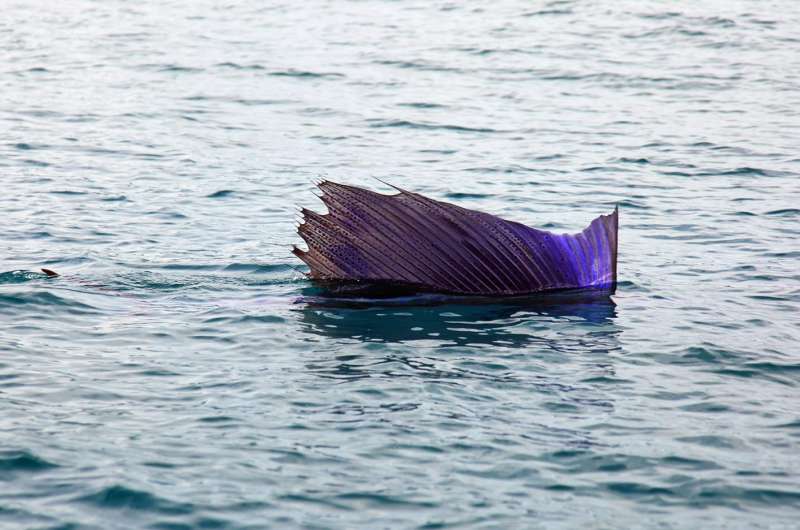November 2, 2016 report
Sailfish found to use group hunting technique to capture more sardines

(Phys.org)—An international team of researchers has found that sailfish use a unique form of group hunting to improve the catch for all involved. In their paper published in Proceedings of the Royal Society B, the group describes their adventures studying the hunting behavior of the fish off the coast of Mexico and why they believe the behavior might be an example of social engagement that could lead to more complex cooperative strategies in other groups of animals.
Most people have likely seen sailfish on television—they have long, pointed bills and fan-like fins on their backs and are generally seen jumping out of the water after being hooked on a fisherman's line. In this new effort, the researchers were interested in the hunting habits of the fish, so they sailed around off the coast of Mexico looking for frigate birds that tend to congregate over hunting areas. Once a hunt was found, the researchers watched and filmed the action.
Studying what they recorded, the researchers found that the sailfish hunted in groups surrounding a school of sardines, but unlike other group hunters, their attacks were not coordinated—instead, individuals would simply swim into the school of sardines and then arrive at the other side. Such forays, the researchers found, resulted in a catch just 24 percent of the time, but, they also found that such attacks also resulted in injuring a sardine approximately 95 percent of the time, which made it easy for the sailfish hanging around in the crowd to grab them. The overall result, the team reports, was a higher per capita capture than would have occurred had the sailfish all hunted alone with less energy expended for all of the participants.
The researchers also found that individual sailfish that opted to take the "free riding" strategy (never actually swimming into the sardine group) only worked if the cost of attacking was high and waiting times were short. They also found that both the size of the sardine group and the sailfish group varied in size—from many members to just a few. Interestingly, the team also noted that the sailfish did not appear to take turns dashing into the sardine mix; instead, attacks occurred at random.
More information: James E. Herbert-Read et al. Proto-cooperation: group hunting sailfish improve hunting success by alternating attacks on grouping prey, Proceedings of the Royal Society B: Biological Sciences (2016). DOI: 10.1098/rspb.2016.1671
Abstract
We present evidence of a novel form of group hunting. Individual sailfish (Istiophorus platypterus) alternate attacks with other group members on their schooling prey (Sardinella aurita). While only 24% of attacks result in prey capture, multiple prey are injured in 95% of attacks, resulting in an increase of injured fish in the school with the number of attacks. How quickly prey are captured is positively correlated with the level of injury of the school, suggesting that hunters can benefit from other conspecifics' attacks on the prey. To explore this, we built a mathematical model capturing the dynamics of the hunt. We show that group hunting provides major efficiency gains (prey caught per unit time) for individuals in groups of up to 70 members. We also demonstrate that a free riding strategy, where some individuals wait until the prey are sufficiently injured before attacking, is only beneficial if the cost of attacking is high, and only then when waiting times are short. Our findings provide evidence that cooperative benefits can be realized through the facilitative effects of individuals' hunting actions without spatial coordination of attacks. Such 'proto-cooperation' may be the pre-cursor to more complex group-hunting strategies.
Journal information: Proceedings of the Royal Society B
© 2016 Phys.org




















